#lefty looks like she wearing a glove of another hand on top with no finger
Text
Oh Skyrim modding is a joy now I’m trying to figure out why oh why is only my left hand disfigured and not my right
#Skyrim#I have 3ba and on bodyslide they both look normal#righty looks normal#lefty looks like she wearing a glove of another hand on top with no finger
8 notes
·
View notes
Text
You’re (Probably) Drawing Archers Wrong
Hello, my name is Len and I’ve shot archery as a hobby for as long as I can remember. I have a problem: fanart depicting archery is oftentimes Very Wrong! I feel like most of this stems from not using good reference pictures, and from a general lack of knowledge. So, I wanted to create a post for anyone interested in accurately drawing an archer! Disclaimer: this is not a comprehensive post or a tutorial on how to shoot, and is intended for artists. That said, if you’re interested in archery, you may still find value in this post, though I recommend doing your own research. I’m certain there will be errors here considering I do this as a hobby not a profession, and I welcome corrections. Finally, archery can be dangerous, and even if you don’t read any more of this post, PLEASE read the safety section.
Safety
This part is going to be a PSA, because the thought of someone reading my post, getting into archery themselves, and doing these things? It terrifies me. So, rules number one, two, and three are: never aim at another person (duh), never use a damaged bow or arrows, and never, NEVER dry fire a bow. Dry firing means drawing back and releasing the string without an arrow. This can make your bow EXPLODE. It can hurt you, and even if your bow doesn’t explode, it’s fucked it up so bad that you should never shoot that bow again. Don’t do it, and don’t draw art of people doing it. Okay, PSA done, now onto the rest of the post.
There’s a TL;DR at the bottom!
First thing’s fist: the equipment! Archery requires four things: a bow, a quiver, arrows, and protective equipment (which is usually what I see most posts lacking). The first thing you should do before you draw your archer is decide what type of bow to give them. I’m not covering crossbows because I’ve only shot one once and I also Hate Them. There are three main types of bows: longbows, recurves, and compounds.
Bows
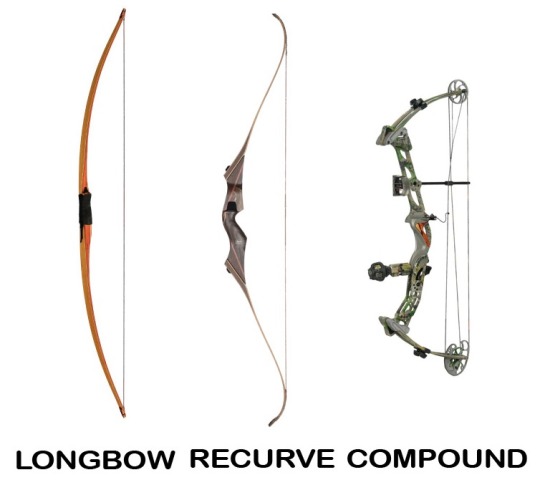
There are two different types of bows that are commonly called a longbow: English longbows, and flatbows (yes I’m considering flatbows a type of longbow to simplify things). English longbows are very large and have a very high draw weight (which means it’s hard to pull the sting back). These were used mainly by the English in the Middle Ages. Flatbows are typically smaller and have a lower draw weight as well as a slightly different profile. These were mainly used by Native American tribes such as the Hupa, the Karuk, and the Wampanoag, as well as prehistoric Europeans and the Finnish, among others. It is often seen in historical fiction and fantasy, and the English longbow is usually depicted as Robin Hood’s preferred bow type. I believe Katniss uses a flatbow in the beginning of Hunger Games, but don’t quote me on that.
Recurves have limbs that curve outwards and are smaller than longbows. Many, many cultures have used these, including but not limited to certain West-coast Native American tribes, the Mongols, the Scythians, the Greeks, the Turks, the Koreans, and the Chinese. Recurves can be made of either wood or of a combination of wood, horn, and glue, making them either composite or non-composite. These are the bows you typically see mounted archers using, and are often used in competitions today. It’s commonly seen in fantasy, and is the bow type used by Legolas, Tauriel, Katniss Everdeen in Mockingjay, Merida, Green Arrow has a lever action, and Hawkeye uses a silly collapsible one.
Compound bows are the most commonly used bow among hunters, are almost always made of fiberglass and either carbon fiber or aluminum, are Technical Looking, and pack the biggest punch for the least amount of effort. It’s a modern invention used worldwide. I don’t know where else to put this, but almost everyone who I know that shoots a compound uses something called a trigger release (pictured below) to draw back the string because it means your release is cleaner.
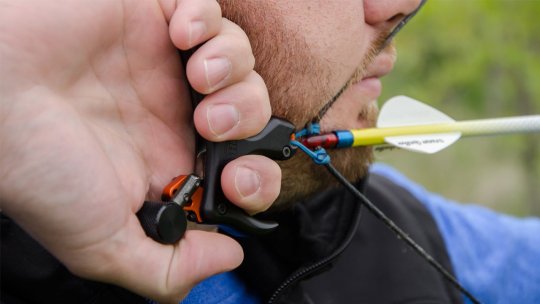
So, those are the main types of bow! Google which bow would be appropriat for the era and region your character is from, or if they’re from space or an alternate dimension, pick whichever you think fits the character the best.
Quivers
There are two types of quiver: back quivers, like Legolas wears, and hip quivers, like those used in the Olympics. Which quiver you should use varies from culture to culture and time period to time period. If it’s fantasy, set in modern day, or set in the future, you can chose whichever you prefer.
Arrows
Arrows can have shafts of wood or fiberglass, can have real feathers or synthetic for fletching, and can have countless different types of heads. The main two that are in use today are called field points and broadheads, and most commercial arrow shafts allow you to freely switch them out.
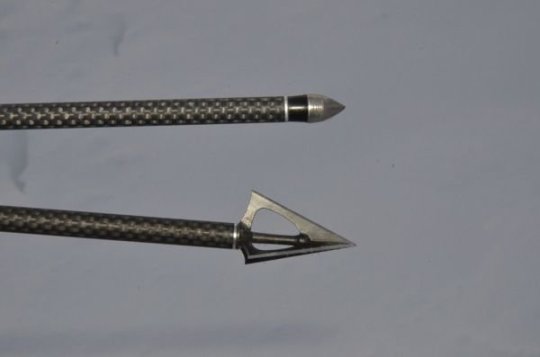
The arrow on the top is a field point, used only for target practice, and the arrow on the bottom is a broadhead, used only for hunting or war. You never hunt with a field point, and never practice with a broadhead. Basically every fictional character out there is shooting to kill, so they’ll all use either a broadhead, or a culturally appropriate variation of deadly arrowhead (bodkin, scythian, flint, etc). Do your research! A Native American wouldn’t use a bodkin, and a Scythian wouldn’t use a flint arrowhead!
Protective Equipment
The one really necessary piece of protective equipment is hand protection. If your character uses a three fingered draw or a pinch draw (we’ll speak on draws later), they need either an archery tab, or an archery glove. If your character is using a thumb draw, they need a thumb ring. These three pieces of equipment keep archers from getting blisters and damaged skin.

This is a tab.

This is the type of glove that I use. All an archery glove needs to do is protect your three draw fingers, but it can be more traditionally glove-like than this one. I’ve even seen ones that are a combination leather bracer and archery glove that give big Fantasy Vibes.

This is a ring. Some historical ones can get REAL ornate and pretty.
Another piece of protective equipment that is commonly used is an arm guard or a bracer. Not everyone uses one, because if your form is good the string should not be hitting your arm, so you can get away with not giving your character one. They can vary in style from something like the more minimal one below up to a full leather bracer.

Form
Form can vary greatly and I’m not about to diss other archery disciplines especially ones I’m ignorant on, so just know that not every culture has the same form. I’m just going to cover a few cultures’ variations, and what I’ve been taught by 21st century Midwest archers. There are several aspects to form, as form is just another term for “everything pertaining to how you shoot”. I’m going to break it down into stance, posture, draw, elbow discipline, holding the bow, and anchor. These are not the only aspects of form (there’s aiming, release, and breath control), but these are the only relevant aspects to drawing archers. I will not be covering mounted archery because I’m sadly ignorant on the topic. I recommend doing your own research and looking into Mongolian mounted archery.
Stance
The thing all stances have in common is that you should put your feet a shoulder-length apart, balance your weight equally between both feet, keep your knees slightly bent, and stand facing approximately 90 degrees away from your target. There are three stances that are common that I’m aware of: squared, open, and closed.

Squared stance means keeping both feet squared up to an imaginary line. Open means that you’re facing slightly towards the target. Closed means you’re facing slightly away. I vary between square and open, and to be honest I’ve never noticed a difference. So long as you draw your character standing with a stable stance, facing away from the target, you should be good.
Posture
Your posture should be with your back straight, your hips squared, and should never have you leaning. Below is one of my favorite archery pictures, not only because I love Marilyn, but because it is a great illustration of what not to do posture wise.
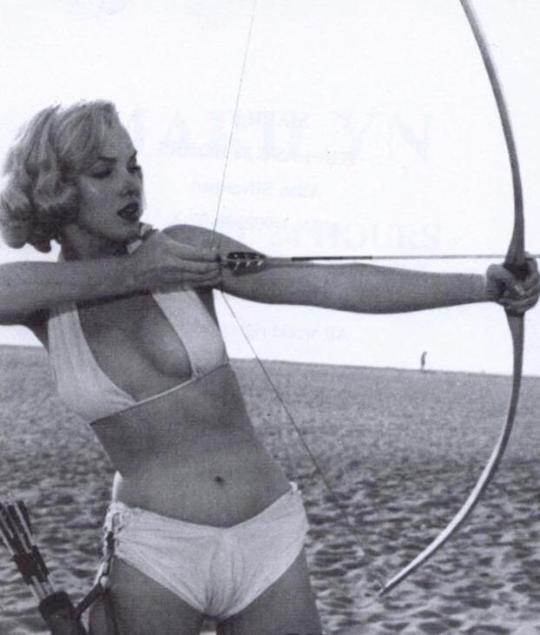
See how she’s leaning back? Yeah, don’t draw your character like that, it looks foolish.
Draw
There are four different types of draw that I’m aware of, I’m educated on three, and I have experience with one (though I’m itching to learn to thumb draw). The types of draw are three fingered draw, otherwise known as Mediterranean draw, pinch draw, thumb draw aka Mongolian draw, and Japanese draw, or torikake. I know fuck all about Japanese draws, so I’m not going to speak out of my ass on topics I don’t understand (if anyone reading practices traditional Japanese archery I would love if you chimed in!). I highly recommend doing your own research on which civilization your character comes from and which draw they use, especially if it’s Japanese because I’m not covering that here.

First up is three-fingered. This is the draw I use, and it’s the most common draw in my limited experience in the Midwestern archery community. It is common in Europe and the Middle East. It requires you to use three fingers, partially wrapped around the string. You do not pinch the arrow. Most people place their index finger above the arrow and their middle and ring finger below, though I’ve seen all different variations. If your character is right handed and uses this draw, draw the arrow on the left side of the bow. Lefties do the inverse, and make sure and draw a left handed bow while you’re at it.
Next is the pinch draw. I’ve never shot with this, nor seen it used. It was common in the Americas and for a time in Ancient Greece. You’re supposed to physically pinch the arrow between your thumb and index finger. Your character would need a full archery glove if you draw them with this grip. The release is supposed to be smooth because there’s only one point of contact, rather than three. I believe you would place the arrow on the right side of the bow when using this technique, but I cannot speak with certainty as I’ve never seen it done (again, lefties would do the opposite).
Last but not least is the thumb or Mongolian draw, though it is/was also widespread in Korea, China, Russia, Persia, Turkey, and the Roman and Byzantine Empires. In this draw you wrap your thumb completely around the string and tuck it behind your other fingers. You do not grab the arrow. This draw utilizes your strongest digit, and so it may be less strenuous than other draws. This draw is commonly used with mounted archery. If your character is right handed and using this draw, put the arrow on the right side of the bow (lefties, do the inverse).
Elbows
Another aspect of your draw that is important is elbow discipline. The elbow of your character’s string hand should not point up into the air. It should point straight back, like the picture below.
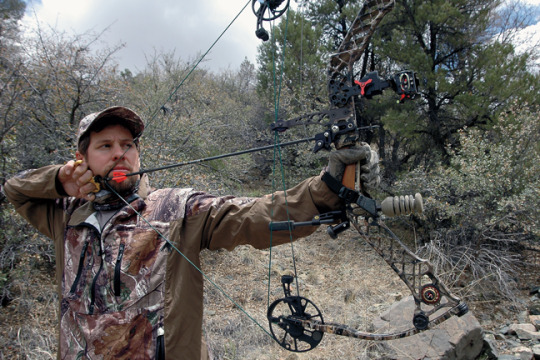
Now, the other elbow is important, too. Don’t draw them with a locked elbow, instead keep it slightly bent and rotated inwards, like the picture below.

Holding the Bow
Your character shouldn’t have a death grip on the bow. Instead, show it resting in the curve between the thumb and index finger. Here’s a wikihow article that describes the different ways to hold different types of bows that is more succinct than I could ever be. Ignore the crossbow (derogatory).
Anchor
Everyone needs an anchor. What’s an anchor, you ask? An anchor is a fixed spot that you draw your string back to whenever you’re going to shoot. It’s necessary in order to ensure consistency, which is accuracy’s best friend. Your anchor spot can vary. I anchor at the corner of my lip. Some people anchor underneath their chin. Some anchor to their ear. I’ve even seen some people in Asian disciplines anchor behind the ear or almost above the head, which is incredibly impressive. Bottom line, unless your character’s archery discipline has them draw behind the ear or above the head, you need to have them touching their head somewhere. The only wrong anchor is a short anchor. If you can’t draw the string back far enough to touch your face, that means you’re either trying to draw back a bow with too high a poundage, or the draw length is too short for you. The picture above of the person with the compound trigger release has a good anchor point on their face. The picture of the person with the arm guard has a good anchor point under their chin.
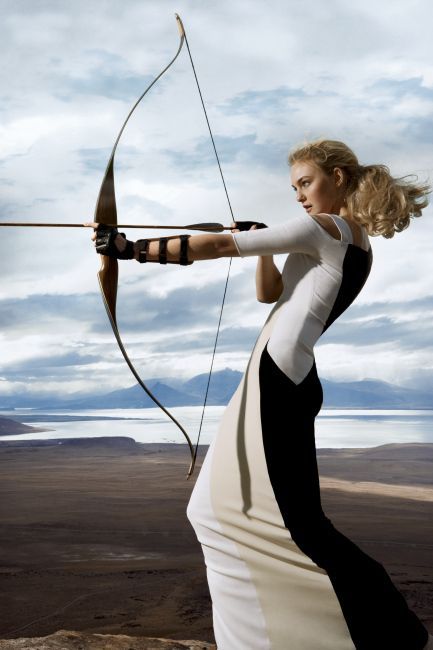
This person, on the other hand? Their anchor is out in space, that is to say they don’t have one (also their elbow discipline, posture, and stance are atrocious). I see this in fanart ALL THE TIME. It’s a pet peeve of mine. Don’t do this, have them anchor to their head or behind it somewhere.
Carrying The Bow
The best way is to just carry it in your hand by the bow (not the string). You can give your character a bow sling, or a back mount like Legolas has as well. You can slip the string over your shoulder and wear it across your back in a pinch, though this may damage the string. The only really wrong way to carry a bow is by the string, though you can damage your bow carrying it on your back if you’re stupid, and I’ve never tried to do so with a compound. Too pokey.
TL;DR
If you’re drawing a fantasy character, go buck wild. Still make sure to give them the right type of arrowhead, hand protection of some sort, a strong stance (no kneeling or sitting), good posture, a sensible draw, elbow discipline, an anchor point (don’t be like the person above!), and a good way to carry their bow, but you can have fun with the rest. If you’re drawing a character from history, research the archery discipline they would most likely use, and draw them with the appropriate bow type, quiver, arrows, protective equipment, stance, posture, draw, elbow discipline, anchor, and bow carry.
#archery#legolas#legolas greenleaf#lotr#tauriel#katniss everdeen#merida#green arrow#hawkeye#clint barton#robin hood#archer#bows#art reference#len speaks#holy FUCK it's complete!#i spent like five hours researching for this post jfc i'm beat#me: *sees one terrible piece of legolas fanart*#me: *cracks knuckles* tiME TO INFODUMP#anyways in conclusion fuck cr*ssbows uwu
1K notes
·
View notes
Text
World: Now running for office, Adam Greenberg. You may remember his first at-bat
GUILFORD, Conn. — Adam Greenberg, wearing a violet tie and an assured expression, inched closer to the edge of his chair at the Guilford Community Center.
At stake was the endorsement of 40 Republican delegates to run for Connecticut’s 12th Senate District seat.
Ted Kennedy Jr., a son of the senator from Massachusetts who died in 2009, had held the seat for four years and was now leaving office.
“I was confident,” Greenberg said last week as he thought back to that moment this spring when he addressed the delegates. “When I’d walk into a batter’s box, I was very prepared.” He said he felt no different as he staked out to the delegates how he would conduct his candidacy.
Greenberg, 37, chief executive of a health and nutrition company, had competition that day. Jerry Mastrangelo, a co-owner of a chain of gyms, was also seeking the Republican endorsement.
And for a while, Vincent Candelora, a Republican assemblyman in Connecticut, thought he would, too.
“But when I heard Adam’s name come up, it took me aback,” said Candelora, who ended up giving the nominating speech for Greenberg and watching him easily beat out Mastrangelo for the endorsement. “I remember thinking, wow, I never thought Adam would ever be interested in this arena. It gets tough, at times. But after I met and spoke to him, I realized it was somewhere he should be.”
And somewhere Greenberg never thought he would be during all those years that he tried to battle back from the beaning he suffered in his first major league at-bat.
A former all-state baseball player at Guilford High School and a ninth-round pick of the Chicago Cubs in 2002, Greenberg was called up to the major leagues on July 7, 2005. The Cubs were in Atlanta, playing the Braves.
“I unpacked my bags at the hotel for my first time as a professional baseball player,” Greenberg said. “I was thinking, I am here to stay.”
Two days later, still preparing for his first moment on the field, he sat at the end of the visitor’s dugout, at what was then known as Dolphins Stadium, as the Cubs prepared to play the Miami Marlins. Cubs manager Dusty Baker had resolved to get Greenberg into a game in Florida because his parents were in town.
“I don’t know what the Cubs expected of him,” Baker said, “but I liked what I saw. His head was on his shoulders as a player and as a person. He was confident but not cocky.”
Greenberg waited for his chance that night, squeezing a bat while wearing batting gloves. In the top of the ninth, with the Cubs leading, 4-2, the team’s pitching coach, Dick Pole, told Greenberg he would be hitting for pitcher Will Ohman.
Greenberg grabbed a helmet. His teammates wished him luck as he climbed the dugout steps.
The Cubs’ first hitter in the ninth, Todd Hollandsworth, grounded out to short against the left-hander Valerio de los Santos.
Then it was Greenberg’s turn. It would be lefty against lefty.
“It didn’t matter to Adam if it was against a right- or left-handed pitcher,” Baker said. “You come up facing everybody. He wanted the at-bat. Every kid remembers his first at-bat.”
Greenberg dug in for the first pitch, slightly bending his knees. It was a 92 mph fastball.
“You get three-tenths of a second,” Greenberg said. “The first tenth I’m thinking don’t bail because if it’s a curve I look stupid, and it’s strike one. The second tenth I realized the ball wasn’t breaking. By the third tenth, my only thought was to get out of the way, and the only thing I could do was to turn into the catcher.”
The pitch struck him under the helmet, the impact sounding like an explosion as he collapsed into the dirt in front of Marlins catcher Paul Lo Duca.
“It scared me to death,” Greenberg said. “My eyes rolled into the back of my head. I grabbed my head because I thought it was split open and that I would bleed out and die. I never lost consciousness. I said two words three times: Stay alive, stay alive, stay alive.”
“Paul Lo Duca looked down and said in a calming voice, ‘Stay down, you are going to be OK,'” he added. “One of the questions the trainers asked me was, ‘Where were you two days ago?’ I said, ‘I was in the minors, and I’m not going back.'”
In the end, Greenberg did go back to the minors — for eight more years. It was a struggle. He had suffered a concussion from the beaning and was then left with vertigo symptoms and vision issues. He did not play baseball the rest of that season and, a year later, with him back in the minor leagues and flailing, the Cubs made the decision to release him.
That led to a minor league odyssey that included stints with other organizations, along with a heavy dose of independent league baseball. A second chance in the major leagues continued to elude him.
In 2009, Greenberg was made aware of a campaign started by a Cubs fan, Matt Liston, to secure him another chance to play in the majors. Nothing came of it.
But several years later, in 2012, after Greenberg had played for Israel in its unsuccessful bid to qualify for the World Baseball Classic, David Samson, then the president of the Marlins, offered him a one-day contract to appear in an end-of-season game against the Mets.
Greenberg accepted, and his new teammates, aware of his saga, embraced him.
“What I remember about him was that he was a cool guy,” said New York Yankees outfielder Giancarlo Stanton, who played right field for Miami that night.
In the bottom of the sixth inning, Marlins manager Ozzie Guillen called for Greenberg, wearing No. 10, to pinch-hit and lead off the inning.
New York Mets pitcher R.A. Dickey, who won a Cy Young Award that season, threw him three knuckleballs. Greenberg took the first for a strike, then swung and missed at the next two.
He walked back to the dugout, his teammates hugging him, the crowd standing and cheering. His major league career was over, but it now included more than just a beaning.
“I wish he had faced Dickey first,” Baker said, thinking back to 2005. “It might have been a totally different story.”
Greenberg remembered feeling overjoyed that he had gotten a second chance, as brief at it was. But the feeling didn’t last long. A week later, his wife Lindsay’s identical twin, Melissa Marottoli Hogan, was admitted to the hospital with Stage 4 lung cancer. She died two months later.
And then, on the night of the funeral, Greenberg got a call from the Baltimore Orioles, inviting him to spring training. Once again, he said, he needed to find a way to balance his emotions.
He was now 32 and running out of time, but he reported to the Orioles early in 2013, still intent on proving he could play at the big-league level. But he was not offered a job. Instead, he again signed with the Bridgeport Bluefish of the independent Atlantic League, giving himself one more chance.
But for the first time, he added, “I had my doubts.”
“My wife was still in trauma,” he said. “My business was taking off. And it began to affect my performance. My average tanked. There was no inspiration to go to the park.”
One night, in a game in Maryland, Greenberg drifted back for a fly ball. It hit the tip of a finger on his throwing hand.
“The finger exploded, split in half,” Greenberg said. “But I went back into the clubhouse feeling more relieved than I’d ever been. Somebody was essentially saying to me, ‘Well, are we good now?'”
He did not play after that season. And by March 2018, his new path seemed assured. Along with running his business, he had written a book and had become a public speaker. And by then a friendship forged at a gymnasium years before was helping to open another door: politics. More specifically, a seat in the state Senate.
“In my position, I have probably talked more people out of running than into it,” said J.R. Romano, chairman of Connecticut’s Republican Party. “I lay down the specifics of what it’s going to take, how hard it will be and the personal difficulties associated with how much they will be attacked. I wanted Adam to know, as a friend, that I was not trying to talk him into something he didn’t want to do.”
Greenberg said the decision to seek the Republican endorsement for the seat was not easy.
“For two nights, I didn’t sleep,” he said. And then he made up his mind to go for it. “Here was the chance to do something on a large scale to help a lot of people,” he said. “I thought I could be that guy.”
And now he will be — if he can win the election. It will not be easy. The Democrats have controlled the seat since 2004, and Kennedy’s two victories over his Republican opponent Bruce Wilson were by enormous margins.
Greenberg does not describe himself as an acolyte of President Donald Trump, who is not particularly popular in parts of Connecticut, a consistently blue state. He said he veers from Trump’s policies in some very specific ways and cited his support for abortion rights.
“I asked the Republican caucus, J.R. Romano specifically, what would my obligations to the party be,” Greenberg said. “When they said you can make your own decisions, I said, ‘I’m in.'”
The Democrats have endorsed Christine Hunter Cohen, the owner of a bagel company in Madison, who sits on Guilford’s Board of Education. Both she and Greenberg are running unopposed in the August primaries.
Nick Balletto, Connecticut’s Democratic state chairman, acknowledged that “Adam has a great story” but maintained that Cohen’s experience in public service would be a significant factor in the November balloting.
Still, the Republicans see a Connecticut footprint that Greenberg can build on. He was born in New Haven, attended public school in Guilford and moved back here in 2013, where he and his wife are raising two sons.
“What I know is what I bring to the table,” he said. “I accomplished something that is very difficult; very few people have a chance to make it to the major leagues. I have been knocked down and gone through tremendous struggles. I can relate to those who also have.”
In a sense, Greenberg is digging in once again, 13 years after a pitch hit him in the head and changed his life. He would appear to be as determined as ever.
This article originally appeared in The New York Times.
John Altavilla © 2018 The New York Times
source http://www.newssplashy.com/2018/07/world-now-running-for-office-adam_30.html
0 notes